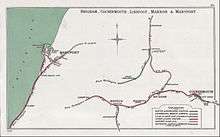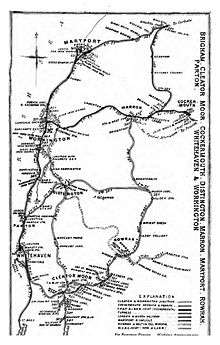Marron Junction railway station
Marron Junction railway station was a later addition to the Cockermouth and Workington Railway. It opened on 2 April 1866 with a single, eastbound, platform when the adjacent Marron Junction opened, two months before the company was absorbed by the London and North Western Railway.
| Marron Junction | |
|---|---|
| Location | |
| Place | Bridgefoot |
| Area | Allerdale |
| Coordinates | 54.6573°N 3.4656°W |
| Grid reference | NY055301 |
| Operations | |
| Original company | Cockermouth & Workington Railway |
| Pre-grouping | London and North Western Railway |
| Post-grouping | London, Midland and Scottish Railway |
| Platforms | 3[1] |
| History | |
| 2 April 1866 | Opened |
| 1 July 1897 | Closed to regular passenger traffic |
| after 1923 | Closed completely[2][3] |
| Disused railway stations in the United Kingdom | |
| Closed railway stations in Britain A B C D–F G H–J K–L M–O P–R S T–V W–Z | |


| Cockermouth and Workington Railway | |||||||||||||||||||||||||||||||||||||||||||||||||||||||||||||||||||||||||||||||||||||||||||||||||||||||||||||||||||||||
|---|---|---|---|---|---|---|---|---|---|---|---|---|---|---|---|---|---|---|---|---|---|---|---|---|---|---|---|---|---|---|---|---|---|---|---|---|---|---|---|---|---|---|---|---|---|---|---|---|---|---|---|---|---|---|---|---|---|---|---|---|---|---|---|---|---|---|---|---|---|---|---|---|---|---|---|---|---|---|---|---|---|---|---|---|---|---|---|---|---|---|---|---|---|---|---|---|---|---|---|---|---|---|---|---|---|---|---|---|---|---|---|---|---|---|---|---|---|---|---|
| |||||||||||||||||||||||||||||||||||||||||||||||||||||||||||||||||||||||||||||||||||||||||||||||||||||||||||||||||||||||
In 1874 an island platform was added to the south of the main east-west line, opposite the single eastbound platform. giving three platform faces.[1]
History
Marron Junction joined the west-east Workington to Cockermouth (later through to Penrith) line with the then new south-north Whitehaven, Cleator and Egremont Railway line from Rowrah. The junction was in open country. It had a substantial triangular layout with an engine shed inside the south-to-east arm.[4] Both the west-to-east and south-to-west arms bridged the River Marron. Marron Junction station was immediately west of the junction's northwestern apex. The triangular layout warranted three signalboxes, one at each apex.
This isolated rural location was further complicated by a branch to Linefitz Colliery running from the west and bisecting the south-to-east arm of the triangle, similarly to Earlestown.[5]
The station was bounded by the River Derwent to the north and was not near any town or village. It was intended as an exchange station for passengers crossing between the east-west and south-north lines. South-north trains terminated at Marron Junction station, from which passengers could travel west or east. The value of this arrangement hinged on the connections.
The station attracted little custom other than railwaymen whose duties took them to Marron Junction.
The station closed to regular passenger traffic in 1897. From then on the south-north trains from Rowrah continued through to Workington Main, an altogether more satisfactory service for its users. Passengers wishing to travel south to east stayed on to the next stop west of the junction - Camerton - and crossed to the other platform to head east.
Although Marron Junction station closed in 1897 railwaymen continued to use it as an unadvertised halt until after 1923.[6]
The south-to-east curve at Marron junction was closed on 1 October 1902.[7] This rendered the south and east signalboxes redundant. The western 'box was replaced to befit its singular role. Normal passenger traffic ended along the south to west curve on 13 April 1931, with normal goods traffic following in 1954.[8] An enthusiasts' special ran south-to-west on 5 September 1954. After scant occasional use the south-to-west line was abandoned in 1960.
Afterlife
By 2015 Marron Junction triangle was readily discernible on satellite images online. The station site appeared to be a footpath through ribbons of trees.
| Preceding station | Disused railways | Following station | ||
|---|---|---|---|---|
| Broughton Cross Line and station closed |
London and North Western Railway Cockermouth & Workington Railway |
Camerton Line and station closed | ||
| Bridgefoot Line and station closed |
Whitehaven, Cleator and Egremont Railway |
References
- Bowtell 1996, p. 32.
- Butt 1995, p. 155.
- Quick 2009, p. 268.
- Griffiths & Smith 2000, p. 328.
- Bowtell 1996, p. 30.
- Croughton, Kidner & Young 1982, p. 100.
- Quayle 2007, p. 78.
- Marshall 1981, p. 163.
Sources
- Bowtell, Harold D. (December 1996). Rails through Lakeland, Volume 1: The Line Described. Kettering: Silver Link Publishing Ltd. ISBN 978-1-85794-066-4.CS1 maint: ref=harv (link)
- Butt, R. V. J. (1995). The Directory of Railway Stations: details every public and private passenger station, halt, platform and stopping place, past and present (1st ed.). Sparkford: Patrick Stephens Ltd. ISBN 978-1-85260-508-7. OCLC 60251199.
- Croughton, Godfrey; Kidner, R. W.; Young, Alan (1982). Private and Untimetabled Railway Stations, Halts and Stopping Places. The Oakwood Press. ISBN 978-0-85361-281-0. OCLC 10507501.
- Griffiths, Roger; Smith, Paul (2000). The Directory of British Engine Sheds and Principal Locomotive Servicing Points: 2 North Midlands, Northern England and Scotland. OPC Railprint. ISBN 978-0-86093-548-3. OCLC 59558605.
- Marshall, John (1981). Forgotten Railways: North West England. Newton Abbot: David and Charles. ISBN 978-0-7153-8003-1.CS1 maint: ref=harv (link)
- Quayle, Howard (2007). Whitehaven: The Railways and Waggonways of a Unique Cumberland Port. Pinner: Cumbrian Railways Association. ISBN 978-0-9540232-5-6.CS1 maint: ref=harv (link)
- Quick, Michael (2009) [2001]. Railway passenger stations in Great Britain: a chronology (4th ed.). Oxford: Railway and Canal Historical Society. ISBN 978-0-901461-57-5. OCLC 612226077.
Further reading
- Anderson, Paul (April 2002). Hawkins, Chris (ed.). "Dog in the Manger? The Track of the Ironmasters". British Railways Illustrated. Clophill: Irwell Press Ltd. 11 (7). ISSN 0961-8244.CS1 maint: ref=harv (link)
- Bairstow, Martin (April 1995). Railways In The Lake District. Martin Bairstow. ISBN 978-1-871944-11-2.CS1 maint: ref=harv (link)
- Conolly, W Philip (1998). British railways pre-grouping atlas and gazetteer (9th impression; 5th ed.). Shepperton: Ian Allan. ISBN 978-0-7110-0320-0. OCLC 221481275.
- Jowett, Alan (March 1989). Jowett's Railway Atlas of Great Britain and Ireland: From Pre-Grouping to the Present Day (1st ed.). Sparkford: Patrick Stephens Ltd. ISBN 978-1-85260-086-0. OCLC 22311137.
- Joy, David (December 1983). Lake Counties (Regional History of the Railways of Great Britain, Volume 14). Newton Abbot: David and Charles. ISBN 978-0-946537-02-0.CS1 maint: ref=harv (link)
- McGowan Gradon, William (2004) [1952]. The Track of the Ironmasters: A History of the Cleator and Workington Junction Railway. Grange-over-Sands: Cumbrian Railways Association. ISBN 978-0-9540232-2-5.CS1 maint: ref=harv (link)
- Marsh, John; Garbutt, John (April 2002). Images of Cumbrian Railways. Sutton Publishing Ltd. ISBN 978-0-7509-2834-2.CS1 maint: ref=harv (link)
- Smith, Paul; Turner, Keith (2012). Railway Atlas Then and Now. Shepperton: Ian Allan Publishing. ISBN 978-0-7110-3695-6.CS1 maint: ref=harv (link)
- Suggitt, Gordon (2008). Lost Railways of Cumbria (Railway Series). Newbury: Countryside Books. ISBN 978-1-84674-107-4.CS1 maint: ref=harv (link)
- Welbourn, Nigel (September 2010). Lost Lines: Joint Railways. Shepperton: Ian Allan Publishing. ISBN 978-0-7110-3428-0.CS1 maint: ref=harv (link)
- Western, Robert (2001). The Cockermouth, Keswick and Penrith Railway. Usk: Oakwood Press. ISBN 978-0-85361-564-4. OL113.CS1 maint: ref=harv (link)
External links
- Map of the line with photos in RAILSCOT
- The station on overlain OS maps surveyed from 1898 in National Library of Scotland
- The station in Rail Map Online
- The railways of Cumbria in Cumbrian Railways Association
- Photos of Cumbrian railways in Cumbrian Railways Association
- The railways of Cumbria in Railways_of_Cumbria
- Cumbrian Industrial History in Cumbria Industrial History Society
- Local history of the CKPR route in Cockermouth
- The line's and station's Engineer's Line References in Railway Codes
- A video tour-de-force of the region's closed lines in Cumbria Film Archive
- Furness Railtour using many West Cumberland lines 5 September 1954 in Six Bells Junction
- McGowan Gradon's 1942 Furness Railway study in Cumberland Archives